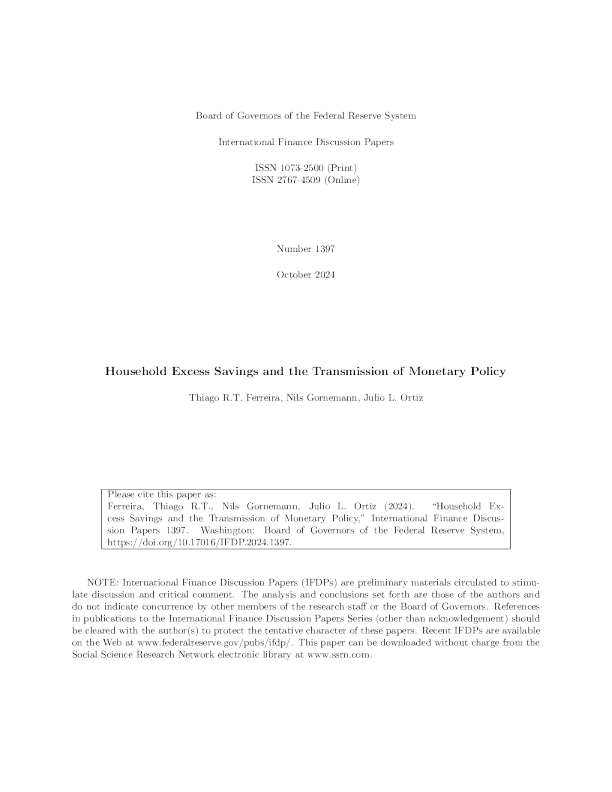美联储过度储蓄的宏观经济效应
 AI智能总结
AI智能总结
美国联邦储备委员会,华盛顿特区,ISSN 1936-2854(印刷版)ISSN 2767-3898(在线版) 宏观经济过剩储蓄的影响 本策·巴尔多奇,杰·辛,以及安德烈亚斯·提斯比雷克 2024-062 请按以下格式引用本论文:Bardoczy, Bence,Jae Sim,和Andreas Tischbirek(2024)。《超额储蓄的宏观经济效应》,金融市场与经济讨论系列2024-062。华盛顿:联邦储备委员会管理委员会,https://doi.org/10.17016/FEDS.2024.062. 注意:金融与经济讨论系列(FEDS)的工作人员论文是用于激发讨论和批判性评论的初步材料。所提出的分析和结论是作者的观点,并不代表研究团队成员或理事会成员的同意。在出版物中引用金融与经济讨论系列(除致谢外)的内容,应与作者商议,以保护这些论文的初步性质。 宏观经济增长效应 Bence Bardoczy Jae Sim Andreas Tischbirek*七月 2024 摘要 我们通过刻画过剩财富被消耗的速度,研究了家庭财富分布冲击的动态一般均衡后果。分析结果将总消费减少率与额外余额的分布、微观跨时期边际消费倾向以及一般均衡反馈联系起来。一个数量化的异质新凯恩斯主义模型匹配了在COVID-19大流行期间积累的过剩储蓄的消耗路径,并在收入分配上进行了匹配。该模型预测消费将获得实质性的但逐渐减弱的提振,并解释了2020年和2021年通货膨胀上涨至40%的原因。 关键词:过度储蓄、异质行动者新凯恩斯主义(HANK)模型、不完全市场、家庭投资组合、通胀动态、COVID-19大流行 JEL 分类:E21, E31, E32, E52 1 引言 家庭财富在商业周期中波动幅度很大,年增长率比战后美国名义GDP的增长率更波动。虽然财富的波动传统上被视为商业周期波动的副作用,但实际上,它们可能反而导致这些波动。积累超额储蓄——即超过正常时期水平的财富——以平滑消费的倾向在家庭之间差异很大。总体的耗尽路径同样掩盖了大量异质性。我们的兴趣在于描述和量化这种超额储蓄的耗尽及其宏观经济影响。疫情时期的超额储蓄提供了一个很好的案例研究,因为超额储蓄分布的估计 readily available。1 在COVID-19疫情期间,美国家庭大幅减少支出并接收了前所未有规模的财政转移支付。尽管收入受损,他们积累的额外储蓄估计在峰值时约为危机前GDP的10%。额外余额的规模和流动性引发了通胀可能迅速上升的担忧,这凸显了模型对储蓄累积结果的不确定性。财政转移支付对额外储蓄积累的巨大贡献可能促使对去储蓄率的两种截然不同的评估。首先,按照经典凯恩斯主义经济学的精神,反复应用较大的边际消费倾向(MPC)预测,超额储蓄将迅速花完。其次,通过具有代表性代理人的标准宏观经济模型咨询得出结论,超额储蓄可能永远不会耗尽,因为超额储蓄是用于资助财政转移支付的超额债务的对应物。与李嘉图等价理论一致,家庭会抵制从超额储蓄中消费,直到政府提高税收来偿还债务。 我们通过依靠一个包含凯恩斯和李嘉图家庭行为的异质代理新凯恩斯(HANK)模型,分析导致过剩储蓄耗尽背后的机制。我们分析的关键主题是,过剩储蓄的分布对其总耗尽路径有强烈影响,因为流动性财富较少的家庭更具有凯恩斯特征,而流动性财富较多的家庭更具有李嘉图特征。我们明确指出,在一般条件下,对家庭财富冲击的局部均衡脉冲响应完全由家庭的时间际边际消费倾向(iMPCs)和过剩财富的分布所决定。2iMPCs亦影响超出储蓄的支出放大,但不足以表征一般均衡中的反应。因此,我们构建了一个使用这些见解校准的定量中型HANK模型,并将其应用于评估大流行时期的效应。 超额储蓄。3 我们首先分析一个在小型HANK模型中财富分配遭受任意冲击后过剩储蓄的耗尽情况。4微型iMPCs(边际消费倾向)反映出在获得额外现金后,家庭在一段时间内的预期消费增长。我们通过分析表明,在局部均衡条件下——即在一定实际利率路径下——总体消费和储蓄的响应完全由初始超额储蓄和微型iMPCs的联合分布决定。由于这一结果与初始超额财富的来源无关,关于测量意外收入产生的iMPCs的实证研究对于耗尽超额储蓄是有意义的。在一般均衡中,iMPCs也会影响超额储蓄支出乘数,但它们不足以表征总体消费。例如,支出具有通胀性,这会通过调整实际利率产生反馈。因此,乘数不仅取决于iMPCs,还取决于菲利普斯曲线的斜率、实际利率对通胀的敏感性,以及利率路径变化对跨时期消费的响应。 我们的定量分析依赖于美国经济的中规模HANK模型。它在两个方面构建了关于iMPCs对消耗超额储蓄重要性的分析结果。首先,我们通过将iMPCs直接与经验估计相联系的计算程序,对模型中的局部均衡消费-储蓄行为进行规范。其次,模型包含了一系列丰富的组成部分,这些部分产生了超出iMPCs单独暗示的现实一般均衡力量。这些组成部分包括由Diamond-Mortensen-Pissarides搜索和匹配摩擦引起的非自愿失业、带有工资调整摩擦的工会纳什谈判、对经济中产生的所有利润权利的模型一致定价、允许资产重估效应的长期政府债务、通过泰勒规则实施的货币政策,以及债务融资的支配地位,以及缓慢调整的扭曲性税收。 手持校准的定量模型,我们评估了新冠疫情后过剩储蓄的孤立影响。基本模拟包括累积期和减持期。前者从大流行的开始一直到2021年第三季度,当时估计整体过剩储蓄存量达到顶峰。在累积期间,模型家庭面临冲击,使得模型能够复制实现的总体消费以及估计的每个收入分配四分位数的过剩储蓄积累。达到过剩储蓄的峰值后,我们将所有冲击限制为零,研究模型关于减持期的预测。 关键发现如下:首先,该模型与可利用实证估计的积累阶段,在总量和每个收入四分位数上的过剩储蓄路径高度一致。其次,第四等份先消耗掉其过剩储蓄,第一等份最后。然而,即使是高收入家庭,大约三年内也会耗尽其过剩储蓄,这意味着它们并不完全是李嘉图的。第三,需求的相应增加解释了2020年上半年至2021年下半年通货膨胀激增的40%左右,这表明后COVID通货膨胀并非完全由供应限制引起。5第四,在累积期,iMPCs和对超额储蓄的初始分配很好地预测了超额储蓄路径。一般均衡反馈会轻微加速超额储蓄的消耗。第五,家庭财政支持的差异可能解释了美国经济活动收缩幅度远小于欧元区的原因。 文献。我们的分析涉及对家庭财富在商业周期波动中的作用的研究以及关于定量HANK模型近期文献的研究。 美国在2007年至2009年全球金融危机期间家庭净值的大幅下降引发了关于家庭财富变化影响的文献的一系列贡献。Mian等(2013) 使用ZIP代码级别的数据来估计危机期间消费对住房财富的弹性。他们发现,住房净值中的平均MPC随着家庭收入和杠杆率的增加而下降。此外,米安和苏菲(2014) 表明在房价财富下降幅度较大的县,就业收缩更为明显,这表明了由 支出反应引发的总体均衡效应。关于房价财富效应的进一步结果包含在Kaplan等人(2020a)和Guren et al.(2021). 证明不仅住房,而且金融财富的恶化会导致消费调整的迹象被呈现出来。克利斯蒂利斯等人(2015),并且赫特科特和佩里(2018) 将家庭资产的低估值与均衡多重性引起的波动联系起来。与这些论文相反,并且与疫情期间积累的过多储蓄相符,我们研究的是高度流动性资产的支出,而不是非流动住房或金融财富的重新估值。此外,我们的分析基于HANK模型,该模型使我们能够评估财富消耗路径上的分布和一般均衡效应的影响。 对超额储蓄的重视是共同的。Auclert 等人(2023b), 使用一个形式化的模型来论证过量储蓄对总需求的长期影响。最初持有美元的贫穷家庭(具有更高边际消费倾向MPC)的一部分将变成财富更丰厚的家庭(具有更低边际消费倾向MPC)的收入,他们会再次支出——这种“向上渗透”的过程会一直重复,直到美元落入超级富豪的手中。我们通过提供一种分析方法来丰富这一认识。 基于最优消费储蓄行为的超额储蓄消耗特征化、构建一个中型规模模型,以及分析疫情后超额储蓄影响的定量分析,考虑到丰富的一套一般均衡力量。 我们的美国经济量化HANK模型与以下模型最为相似:Auclert 等人(2020)和拜耳等人。(2024与上述两种模型相比,我们的模型通过包含搜寻和匹配摩擦以及工资谈判,允许在广泛的劳动边际进行调整。首先,我们模型化了对所有经济中产生的利润进行定价的金融中介机构,但允许中介机构累积净财富。中介机构保留盈余的分配,与他们框架中的非流动账户的分配相当——我们从这一点上抽象出来。在后一种情况下,家庭可以以Calvo类型的概率最优地调整一个非流动账户,但是垄断利润是由企业家收取的,这排除了对我们的结果非常重要的股权重估效应。 尽管他们本身并不关心过度储蓄,Carroll et al.(2021)和拜耳等人。(2023) 使用量化模型来研究2020年3月通过的CARES法案的影响,该法案导致了超额储蓄的积累。我们将对这些在大流行初期实施的财政措施的分析视为对我们分析的有益补充。最后,大量论文试图回答与COVID-19大流行具体相关的问题——例如,通过开发具有经济和流行病学特征的模型。6我们的工作也与该文献流有所关联,但我们的兴趣在于更广泛地探讨过度财富减值的影响。 概述。本文的其余部分组织如下。第 sections 2借鉴了一个 stylized HANK模型来提供关于部分均衡和一般均衡中过剩储蓄动力学的分析结果。第3阐述了定量模型。第4解释了我们的校准策略,该策略基于分析结果。第5本研究通过我们的模型视角,分析了COVID-19疫情之后储蓄过度的宏观经济效应。最后一节进行了结论。 检查超额储蓄的消耗 在本节中,我们将过剩储蓄置于工作马宏观经济模型中。我们提出两个将指导我们定量作业的观察结果。首先,在局部均衡中,iMPCs和初始过剩储蓄的联合分布足以描述消耗速度。这一结果在广泛的消费-储蓄模型中,无论过剩储蓄的原始原因如何,都是成立的。其次,在一般均衡中,iMPCs也会影响乘数,但不再足够。过剩储蓄的减少是一个 总需求冲击对价格上涨产生向上压力。因此,菲利普斯曲线的斜率和财政及货币政策制定者的应对措施,对确定对宏观经济最终影响的相关性变得重要。 2.1 部分均衡 我们从考虑标准的非完备市场(SIM)模型开始,它是异质经济体宏观经济学中的主要模型。我们使用SIM模型在微观层面上对iMPCs给出一个形式定义,并认为它们完全描述了在有条件于实际利率路径的背景下,超额储蓄累积过程。7此结果在包括标准代表性代理和消费者-储蓄者模型在内的更广泛模型类中都成立。 ∈[ ]SIM模型i 存在一个以家庭为指数单位的单元质量。0,1个人面临特殊的收入风险,并且在单一的非国家相关资产中交易。贝尔曼方程是() = ,(3)+ = ( + ) + c a r a y s.t. 1 , (2) − − t it it 1 it it , , , 1 ,≥ a a it ,( ) +[V y au cV 尽管将收入和资产作为独立的状态变量通常是有用的,但它掩盖了SIM模型的一个众所周知的属性,这个属性对于思考超额储蓄至关重要。= ( +)+[],, 1→u它, , 1,E()] xr a y x在上一期期末:R R这是一个满足以下条件的标准周期效用函数:∈ya −t+t0, 1 是折扣因子,是资产的实体现金流量回报率。t1它它, 1 , 对于所有1,超额储蓄与iMPCs。ix it h,考虑一个初始手头现金为一定数额的家庭,该家庭收到的 现金在手成分的波动对家庭的决策无关紧要。这是+i a暗示着进入了一个有超额储蓄的时期具有与...相同的含义。−,0一期一次的转移在期0。我们的目标是比较其在所有期的消费-储蓄选择。≥t 它, 1∆+ ( +)yr获得收入1这是一个关键观测,意味着广泛的…−0与无转移的对照。使用一次性转移来产生超额储蓄在一般意义上是可行




